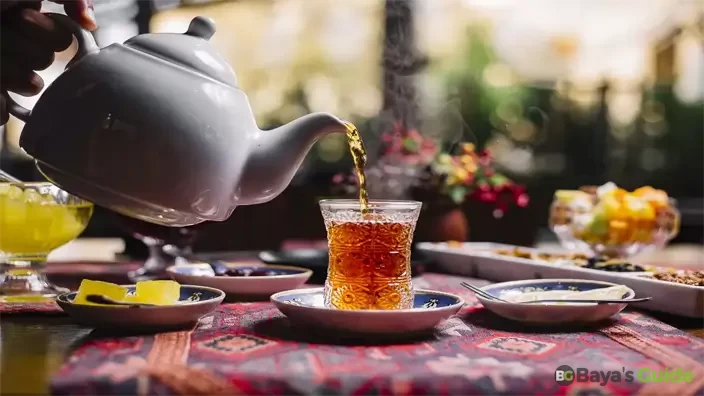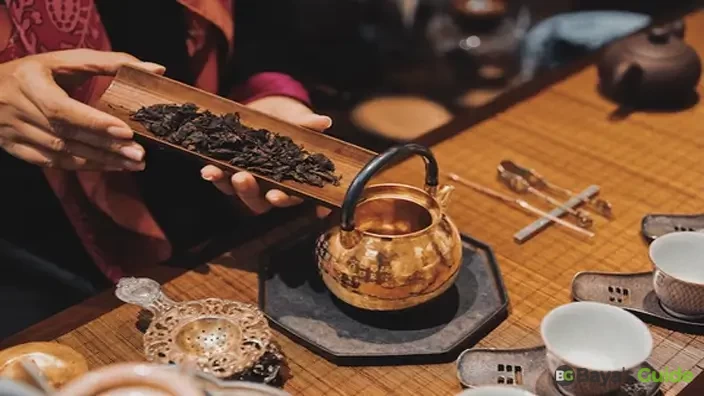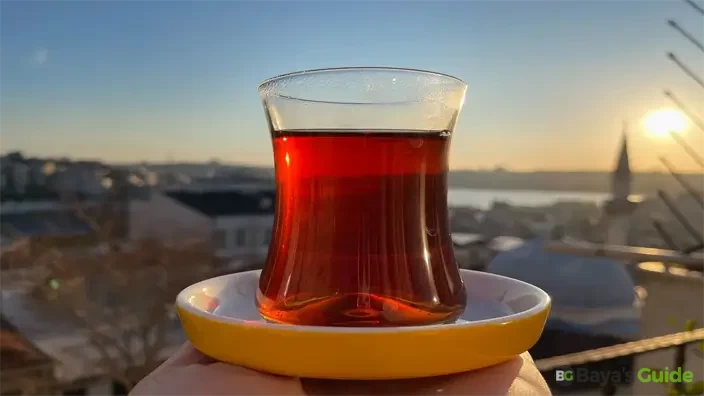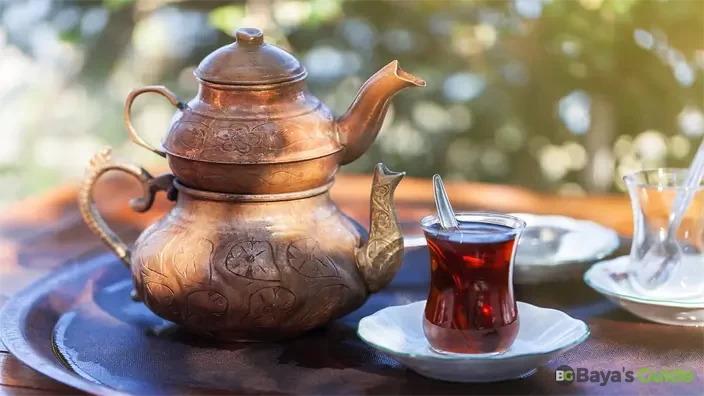Step into the enchanting world of Turkish tea, where each cup tells a tale of tradition, hospitality, and a deep-rooted cultural connection. Originating from the vibrant landscapes of Turkey, this aromatic beverage holds a special place in the hearts of many.
In this guide, we embark on a journey to demystify the art of making Turkish tea – a process that goes beyond a simple brewing method; it's a celebration, a social ritual, and an experience that transcends taste. Join us to unveil the secrets to crafting the perfect cup of Turkish tea, inviting you to partake in the rich heritage that steeps within every sip.
Table of Contents
- Why Is Turkish Tea Special?
- Decoding Turkish Tea: Flavors, Traditions & Brewing Wisdom
- Brewing Turkish Tea In Traditional Kettle
- Turkish Tea Recipe: Essential Ingredients
- Step 1: Selection Of Your Favorite Black Tea Leaves
- Step 2: Quantity Of Water
- Step 3: Rinse The Tea Leaves
- Step 4: Prepare The Kettle
- Step 5: Quantity Of Black Tea
- Step 6: Let It Steam
- Step 7: Brew The Tea
- Step 8: Adjust The Strength
- Step 9: Boil The Tea Leaves On Low Heat
- Step 10: Serve In Turkish Tea Glasses
- Step 11: Add Sugar (Optional)
- Step 12: Enjoy The Ritual
- Double Boiler Method For Making Turkish Tea
- Essentials For Brewing Traditional Turkish Tea
- Step 1: Rinsing The Tea Leaves
- Step 2: Set Up The Double Boiler
- Step 3: Steam The Tea Leaves
- Step 4: Add Water To The Top Boiler
- Step 5: Monitor & Adjust
- Step 6: Serve Turkish Tea In Classic Glassware
- Step 7: Sweeten To Taste (Optional)
- Step 8: Savor The Moment
- Preparation Tips
- Frequently Asked Questions
- Conclusion
Why Is Turkish Tea Special?
All tea connoisseurs generally but Turkish people particularly have a special association with Turkish tea. They serve tea as an indispensable part of hospitality. It cannot be ignored in any gatherings, events, and celebrations or even when two friends sit to have a chat between them. In Turkey, people invite family members, relatives, and friends to tea ceremonies.
Decoding Turkish Tea: Flavors, Traditions & Brewing Wisdom
- Turkish tea is formed with black tea leaves and brings in three strong flavors:
- Koyu (Powerful)
- Tavşan kanı (Standard)
- Açık (Light)
- Use a double boiler resembling a traditional kettle to brew Turkish tea.
- Soak your tea leaves for 10-15 minutes in the pot.
- Add further favoring items such as sugar and lemon.
- Serve your tea with a snack such as sweet baklava or borek.
Brewing Turkish Tea In Traditional Kettle
Turkish Tea Recipe: Essential Ingredients
- Turkish Tea Leaves (Çay)
- Water
- Traditional Kettle
- Tea Glasses (Fincan)
- Sugar (optional)
- A Teaspoon
Step 1: Selection Of Your Favorite Black Tea Leaves
Select the best brand of black tea leaves on hand at a tea shop or a grocery store. The strength of your favorite tea depends not on the brand or tea quality, rather it is contingent on the quantity of water that you add to boil the tea to infer the base flavor.
For the best flavor and tea hue, you need to brew the tea with a strong base with dark tea leaves like Assam, Darjeeling, and Nilgiris. Over and above, you may add some herbal teas like chamomile, mint, cinnamon, ginger, apple, anise seeds, rosehip, peppermint leaves, hibiscus, rosemary, or lemon to enhance the flavor and odor of your tea.
Step 2: Quantity Of Water
Fill your teapot with 5 cups (1,200 mL water in the teapot beneath after removing the upper pot. Then place the upper teapot on it again. It’s better to use filtered water or let the pipe water run out if you’re using tap water.
Step 3: Rinse The Tea Leaves
Start by rinsing the Turkish tea leaves under cold water. This helps to remove any impurities and prepares the leaves for brewing.
Step 4: Prepare The Kettle
Before brewing Turkish tea in a kettle, ensure it's clean and free from residues. A well-maintained kettle contributes to the rich flavor and aroma of the tea.
Step 5: Quantity Of Black Tea
When the water in the teapot comes to a boil, you can add 2 black teaspoons (28.3 grams) to the teapot after removing the lid. Plus, you can addloose-flavored tea 1 tablespoon with the addition of base flavors like lemon, orange, grapefruit, or Earl Gray. Store and save the remaining Turkish tea leaves in a sealed air-tight package to keep them saved from clamminess and bad odor.
Step 6: Let It Steam
Allow the tea leaves to steam over low heat. This process brings out the rich flavor of the tea. Be patient; this step may take around 15-20 minutes.
Step 7: Brew The Tea
Once the tea leaves have steamed, add hot water to the top kettle. The ratio of tea leaves to water can vary based on personal preference, but a common ratio is one teaspoon of tea leaves per cup of water.
Step 8: Adjust The Strength
To control the strength of the tea, you can adjust the amount of water and tea leaves. For a stronger brew, reduce the water; for a milder taste, increase it.
Step 9: Boil The Tea Leaves On Low Heat
After getting 2-3 boils, you should let the pot stay on low heat turning the stove knob to 2 for about 10 to 15 minutes. Put the kettle in a bubbling position while lowering the heat level. This is the right moment to serve the tea.
Step 10: Serve In Turkish Tea Glasses
Pour the brewed tea into Turkish tea glasses. These are small, tulip-shaped glasses that allow you to enjoy the aroma and color of the tea.
Step 11: Add Sugar (Optional)
Turkish tea is often served with sugar. If desired, you can add sugar cubes to your tea glass. Stir it gently until the sugar dissolves.
Step 12: Enjoy The Ritual
Turkish tea is not just a beverage; it's a social ritual. Sip your tea slowly, engage in conversation, and savor the moment.
Double Boiler Method For Making Turkish Tea
Turkish Tea is the most liked in all over the world with the triple categories: dark, brownish red, and shaky light color. The strength and texture depend upon how much water you have diluted with leaves. There are a few types of tea leaves you may choose the best of them.
Essentials For Brewing Traditional Turkish Tea
- Turkish Tea Leaves (Çay)
- Water
- Sugar (Optional)
- Turkish Teapot (Çaydanlık)
- Tea Glasses (Fincan)
- Double Boiler
Explore More: How To Wash Crochet Blanket
Step 1: Rinsing The Tea Leaves
Begin by rinsing the Turkish tea leaves under cold water and ensuring that they are clean and ready for brewing.
Step 2: Set Up The Double Boiler
Place water in the bottom compartment of the double boiler and the rinsed tea leaves in the top compartment. This method allows for a gentler and more controlled brewing process.
Step 3: Steam The Tea Leaves
Set the double boiler on low heat and let the tea leaves steam for approximately 15-20 minutes. This step helps unlock the full flavor potential of the tea.
Step 4: Add Water To The Top Boiler
After steaming, pour hot water into the top compartment of the double boiler. The ratio of tea leaves to water can be adjusted based on your desired strength, typically around one teaspoon of tea leaves per cup of water.
Step 5: Monitor & Adjust
Keep a close eye on the brewing process. The double boiler allows for precise temperature control, ensuring the tea brews to perfection. Adjust the heat if necessary.
Step 6: Serve Turkish Tea In Classic Glassware
Once the tea is brewed to your liking, carefully pour it into the traditional Turkish tea glasses, allowing the rich aroma to fill the air.
Step 7: Sweeten To Taste (Optional)
For those who prefer a hint of sweetness, add sugar cubes to your tea glass. Stir gently until the sugar dissolves.
Step 8: Savor The Moment
Embrace the beauty of the double boiler method as you savor each sip of your meticulously brewed Turkish tea. Share this exquisite experience with others, celebrating not just a drink, but a cultural legacy steeped in warmth and tradition.
Preparation Tips
- Adjust the tea-to-water ratio for your desired strength.
- Traditional Turkish tea is served without milk.
- Enhance the experience by pairing it with Turkish delight or other sweets.
Frequently Asked Questions
What Is a Turkish Tea Set?
A Turkish tea set is known for its unique style that normally holds four items as follows:
- Turkish tea glasses
- Turkish Small plates used the glasses to put on
- Turkish mini teaspoons
- A tray used to serve tea glasses
What Is Traditional Turkish Tea Made Of?
Though there are a variety of black teas but amongst them Turkish tea is the closest to everyone’s heart. That is grown mostly on the coasts of Turkey. The black leaves are collected and pestled in a powder form. Then, the black tea powder is brewed in a traditional kettle and further served in Turkish tea glasses that are known as "thin waist” after roasting and boiling with an oxidation method given above in the article to ferment it well.
How Is Tea Made In Turkey?
Tea with normal water does not give you the required flavor, odor, and texture. First, you need to bring the water to a boil in the lower teapot and transfer some of the water to the smaller teapot that is set on the lower teapot’s mouth. Put 2 black teaspoons and 1 spoonful of loose leaves of black tea. By and by transfer your stove to the lower flame that only can produce steam in the pot. Noticing the tea water bubbling, you can serve it in Turkish tea glasses, particularly designed for Turkish tea, and enjoy a strong form and flavor.
What Spices Are Used In Turkish Tea?
Turkish tea typically includes black tea leaves and is served in small glasses. However, it's not heavily spiced like some other teas. If you're looking for spiced tea in Turkish cuisine, you might be interested in "çayı demleme" or Turkish spiced tea, which can include spices like pepper, cloves, cinnamon, fennel, cumin, cardamom, and parsley.
Conclusion
In conclusion, delving into the art of making Turkish tea unveils more than just a brewing method—it's an exploration of tradition, cultural connections, and warm hospitality. With each sip, one experiences the rich flavors and aromas that signify more than just a beverage; it's a social ritual and a celebration of shared moments. Whether brewed in a traditional teapot or a double boiler, the journey to craft the perfect cup is a captivating one, inviting individuals to embrace the cultural legacy encapsulated in this cherished Turkish tradition.























